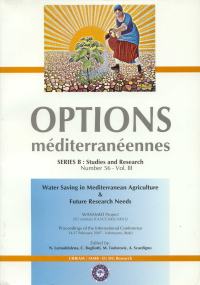| Article précédent | p. 87-98 | Article suivant |
Optimal water productivity of irrigation systems in a semi-arid region
Optimal water productivity can be achieved if crop type and plant density are optimized. This optimization will make it possible to plan and to make decisions regarding revision of and changes in cropping pattern over short periods in order to realize a demand-oriented water distribution system in irrigation networks. It is the objective of the present study to develop a nonlinear model for determining optimal cropping pattern under different water regimes. The objective function of the model is the water productivity index defined as the net profit to the volume of water used. Using the data and information collected from Ghazvin irrigation network located in a semi-arid region in Iran, the developed model was executed and the results obtained were evaluated. The results show that among the crop types grown in the region, sunflower had the highest water productivity value while tomato had the lowest. These values under drought conditions for optimal cropping pattern of the two crops were estimated at 1778.96 and 353.22 Rials/m3. The overall water productivity of the irrigation network with relevant cropping pattern management can rise to as high as 504.38 Rials/m3 under drought conditions. This is while in normal and wetty years, depending on the water available and the optimal cropping pattern, the values for this index are estimated to be 535.352 and 667.13 Rials/m3, respectively. Investigations show that under drought conditions, the water productivity of the irrigation network could be raised to as high as the value in normal years.
La productivité optimale de l'eau peut être atteinte si le type de culture et la densité des plantes sont optimisés ce qui rendra alors possible la planification et la prise de décisions pour réaliser les modifications et les changements nécessaires à la réalisation d'un système de distribution de l'eau en fonction de la demande dans les réseaux d'irrigation. L'objectif de cette étude est de développer un modèle non linéaire qui détermine le mode de culture optimal selon différents régimes d'irrigation. La fonction du modèle a pour but de créer un index de productivité de l'eau défini comme le bénéfice net par rapport au volume d'eau utilisé. Les résultats montrent que parmi les cultures produites dans la région semi-aride de Ghazvin, en Iran, le tournesol obtient le taux de productivité de l'eau le plus élevé et la tomate, le plus bas. Ces valeurs sont estimées à 1778.96 et 353.22 rials/m3. La productivité générale de l'eau du réseau d'irrigation, en appliquant les modes de culture optimisés, peut atteindre 504.38 rials/m3 en condition de sécheresse. C'est pourquoi en période normale ou humide, en fonction de l'eau disponible et de la conduite optimale de la culture, les valeurs de cet index sont respectivement estimées à 535.352 et 667.13 rials/m3. Les recherches montrent qu'en condition de sécheresse, la productivité de l'eau du réseau d'irrigation peut atteindre les valeurs des années normales.
- [ Afficher ]
- [ Télécharger ]
- [ Exporter la citation ]
Vous pouvez télécharger la citation au format :
- [ Imprimer ]
-
Mots-clés
CALENDRIER DES IRRIGATIONS, CONDUITE DE LA CULTURE, IRAN REPUBLIQUE ISLAMIQUE, METHODE D'OPTIMISATION, MODELE, PRODUCTIVITE, RESEAU D'IRRIGATION, UTILISATION DE L'EAUCiter cet article
Montazar A., Nazari Far M.H., Mardi E. Optimal water productivity of irrigation systems in a semi-arid region. In : Lamaddalena N. (ed.), Bogliotti C. (ed.), Todorovic M. (ed.), Scardigno A. (ed.). Water saving in Mediterranean agriculture and future research needs [Vol. 3]. Bari : CIHEAM, 2007. p. 87-98. (Options Méditerranéennes : Série B. Etudes et Recherches; n. 56 Vol.III). Proceedings of the International Conference WASAMED Project (EU contract ICA3-CT-2002-10013), 2007/02/14-17, Valenzano (Italy). http://om.ciheam.org/om/pdf/b56_3/00800206.pdf



